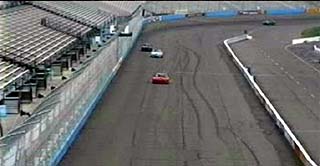 |
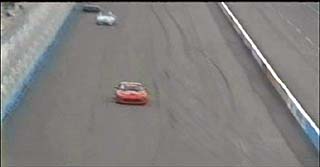 |
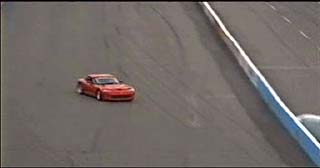 |
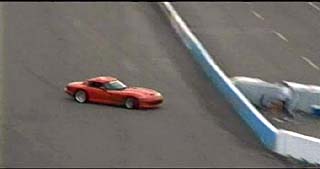 |
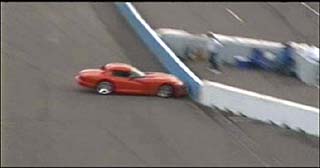 |
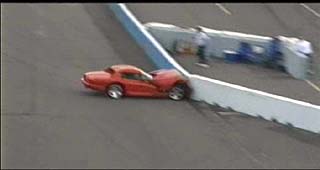 |
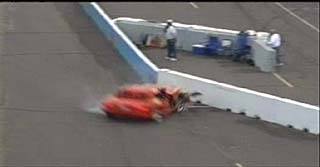 |
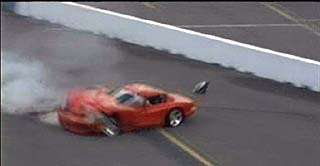 |
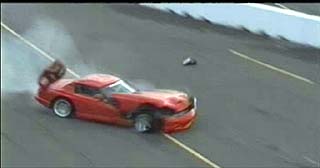 |
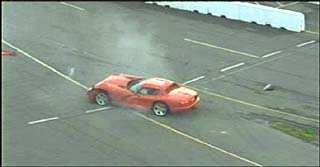 |
2000 Viper Roadster Crash
Phoenix International Raceway - 11/30/2002
Dave's Page • Family
Web Page:
Send eMail to Dave
1.8MB mpg file of the incident
Photo Montage captured from the video
 |
 |
 |
 |
 |
 |
 |
 |
 |
 |
| Text of the Report that I filed about the incident (names
removed)
Analysis
of On-Track Incident at Phoenix International Raceway – November 30,
2002 Student:
Xxxxx Xxxxxxxx Vehicle:
2000 Dodge Viper Roadster The morning began with an on-track “station-wagon” session. During this low speed introductory event I took Mr. Xxxxxxxx out for a ride in my 1988 Porsche 944 to show him the line that would be presented to him in the classroom and to show him some of the points of interest that he should pay particular attention to. In particular I showed him the areas that I always stress during these ride-along sessions:
When
the students were released from their first classroom session I was
waiting outside and seeing Mr. Xxxxxxxx I asked him if he had an
instructor to ride with him yet. He
did not, so I climbed into his car and directed him to drive up to the
grid in the cold pits to wait for his session to begin. While
sitting in his car waiting to be released to go on track I asked him some
questions about his car and how long he had owned it. He indicated that this was his second Viper and that he had
not done any schools before but that he had driven on PIR during a ride
around session during a Grand-Am event. As
I normally do I reiterated to him that this was not a race session and
that we would not be allowed to pass on the corners, just on the
designated straights and that there was an established speed limit on the
front straight of no more than 100 miles per hour.
I told him the saying that I tell every student and prospective
student, “you drove the car out here and you want to drive it home”,
therefore, “only drive the car to the level that you feel comfortable
doing – don’t push it”. With
that said we eventually headed out onto the track. The first four or five laps were uneventful and I found
myself quite impressed that by the second lap he appeared to have mastered
the concept of T7, albeit at a fairly low speed but on the line
nonetheless. He was driving
correctly through the pit boxes between T1 and T2 even though some of the
cars in front of us were off this line.
His entrance to T2 was not quite late enough but was starting to
get better with each lap as he saw the benefit to turning in later each
time as I explained to him upon exiting T3. Eventually
we found ourselves with only one car, a BMW Z3, in front of us as we
exited T9 onto the Oval and Mr. Xxxxxxxx stayed low on the exit and the Z3
stayed high to wave us by when we passed.
This would be his first trip down the front straight were he was
not following another student or Novice Street Session driver.
He transited through the Oval at almost 70 miles per hour with a
comfortable line and speed that did not present any noticeable feelings on
the senses. Once onto the front straight he opened up the throttle a bit
but maintained the established speed limit. In fact he indicated later,
although I did not actually feel it, that he brushed the brakes once to
stay under this limit. On
turn-in for T1 he put in the clutch and I believe went down from fourth to
third and then second and let out the clutch before I could say anything.
As soon as he let the clutch back out the rear end locked up and
around the car came. I then
found us sliding passenger side first toward the wall and the T1 worker
area. At first I thought we
were going to miss the wall and if Mr. Xxxxxxxx had moved the wheel
slightly with the direction of the spin to bring the nose back around
rather than into the spin try and stop it we would have.
As it were we hit with a glancing blow and came to a rest a short
distance away and on the gore area between the transition of NASCAR 1 and
the Road course T1 facing toward the rest of the cars coming through T1
and looking out through the now raised hood of the vehicle. I
restrained Mr. Xxxxxxxx from exiting the vehicle until the corner workers
had secured the area with yellow flags (which were out and waving
immediately) and that the emergency crew had arrived to act as a roadblock
for us with the wrecker. Once
they arrived and parked in front of us I allowed Mr. Xxxxxxxx to exit the
vehicle. While
waiting in the vehicle for the above to occur I gave the corner workers a
“thumbs-up” to indicate that we appeared to be ok and uninjured and
started the debrief with Mr. Xxxxxxxx when he asked “what did I do
wrong?” I told him that the
incident was caused due to his downshifting as he entered T1.
He indicated to me that “no one” had told him not to do that.
I did not argue with him as that was not the time or place given
his current state of mind and agitation but I know that I mentioned it
during the station wagon session as this is part of my normal delivery
during those sessions and I know that this is a topic of one of the slides
during the PowerPoint presentation in the first classroom session. Once
out of the vehicle we were checked over by the Ambulance Crew and Mr. Xxxxxxxx
was actually transported back to the infield while they took his vitals
and filed out there evaluation sheet on him.
I stayed out to walk Ralph Evans and Gene Felton through a quick
review of what had happened and looked at the point of impact with the T1
wall. I then walked back to
the paddock area to collect Mr. Xxxxxxxx from the ambulance crew and sit
him down for a bit of a more formal debriefing. I
took him to the picnic table by Mr. Mort’s mobile canteen and bought him
a Coke to help settle his nerves. About
this time the wrecker crew showed up with his car and I left him to find a
spot for them to set it down and to get borrow some jack stands to set the
nose on so as to make it easier to pick backup later when the car would be
transported out of the facility. When
I returned to Mr. Xxxxxxxx he had already talked to Al Box of Fat Albert
Auto Body about having his car transported to his facility for repairs and
a wrecker had been called to come collect the vehicle. Mr.
Xxxxxxxx and I continued our debriefing as to what caused the incident and
I collected his personal information so that I could prepare this report
for him and for ASRA. I
told him that he because he had slower cars in front of him for his
previous trips down the front straight they had helped to modulate his
speed, braking and line to the point that he had not had an issue before
the incident since he had not actually been able to get up to the speed
limit and therefore had not needed to actually brake as much as he found
himself needing to do once he was out front. Once
we had concluded our talk I took Mr. Xxxxxxxx over to meet with Ralph
Evans so that an Incident Report could be completed and so that Ralph
could assist Mr. Xxxxxxxx - in properly reporting this drivers school
incident to his insurance carrier for coverage. David
W. Riddle
|
The pictures on these pages are © 1995-2003 by David W. Riddle